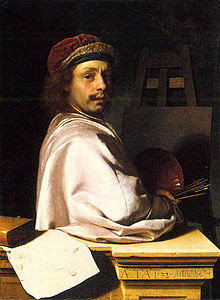Frans van Mieris the Elder
| Frans van Mieris | |
|---|---|

Frans van Mieris self-portrait.
|
|
| Born |
Frans van Mieris 16 April 1635 Leiden, Dutch Republic |
| Died | 12 March 1681 (aged 45) Leiden, Dutch Republic |
| Nationality | Netherlands |
| Known for | Painting |
| Movement | Baroque |
Frans van Mieris, the elder (16 April 1635 – 12 March 1681), was a Dutch Golden Age genre and portrait painter. The leading member of a Leiden family of painters, his sons Jan (1660–1690) and Willem (1662–1747) and his grandson Frans van Mieris the Younger (1689–1763) were also accomplished genre painters.
Frans was born and died in Leiden, where his father Jan Bastiaans van Mieris was a goldsmith, carver of rubies and diamond setter. His father wished to train him to his own business, but Frans preferred drawing, and studied with Jacob Toorenvliet's father, Abraham Toorenvliet, a glazier who kept a school of design. From his own father's shop he became familiar with the ways and dress of people of distinction. His eye was fascinated in turn by the sheen of jewelry and stained glass; and, though he soon left Toorenvliet for the workshops of Gerard Dou and Abraham van den Tempel, he acquired the Leiden fijnschilder manner over the Amsterdam finish of the disciples of Rembrandt.
It should be borne in mind that he seldom chose panels of which the size exceeded 12 to 15 inches, and whenever his name is attached to a picture above that size we may surely assign it to his son Willem or to some other imitator. Unlike Dou when he first left Rembrandt, or Jan Steen when he started on an independent career, Mieris never ventured to design figures as large as life. Characteristic of his art in its minute proportions is a shiny brightness and metallic polish.
The subjects which he treated best are those in which he illustrated the habits or actions of the wealthier classes; but he sometimes succeeded in homely incidents and in portrait, and not infrequently he ventured on allegory. He repeatedly painted the satin skirt which Ter Borch brought into fashion, and he often rivalled Ter Borch in the faithful rendering of rich and highly coloured woven tissues. But he remained below Ter Borch and Metsu, because he had not their delicate perception of harmony or their charming mellowness of touch and tint, and he fell behind Gerard Dou, because he was hard and had not his feeling for effect by concentrated light and shade. In the form of his composition, which sometimes represents the framework of a window enlivened with greenery, and adorned with bas-reliefs within which figures are seen to the waist, his model is certainly Dou.
...
Wikipedia
